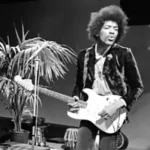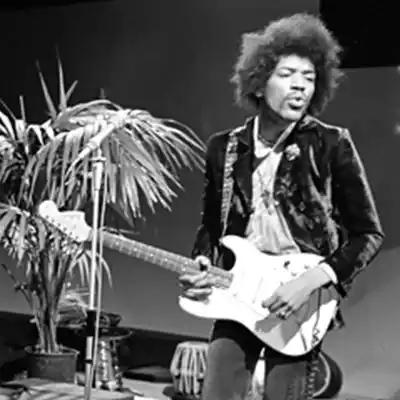
Jimi Hendrix – Life, Guitars and Legacy
Jimi Hendrix remains one of the most iconic and influential guitarists in music history. His innovative guitar techniques and revolutionary sound captivated audiences during his short-lived yet impactful career.
In this post, we delve into the life of Jimi Hendrix, the guitars and equipment that contributed to his unique sound, and the lasting influence he has had on the world of music.
Table of Contents
Early Life and Career
Johnny Allen Hendrix was born on November 27, 1942, in Seattle, Washington. His love for music began at an early age. He received his first guitar, a simple one-string ukulele, from his father, Al Hendrix, when he was just 15. He quickly progressed to an acoustic guitar, and by 16, he was playing an electric guitar, practicing relentlessly to master the instrument.
After a brief stint in the military, Hendrix began his professional music career by working as a backing guitarist for acts such as Little Richard, the Isley Brothers, and Curtis Knight & the Squires. It wasn’t until he moved to England in 1966, under the guidance of former Animals bassist Chas Chandler, that he formed his own band, the Jimi Hendrix Experience, and gained international recognition.
The Jimi Hendrix Experience released three groundbreaking albums: “Are You Experienced?” (1967), “Axis: Bold as Love” (1967), and “Electric Ladyland” (1968). These albums showcased Hendrix’s skill as a guitarist, his innovative sound, and his ability to blend various genres, including rock, blues, and psychedelic music.
Guitars
Jimi Hendrix was known for playing various guitar models, but the Fender Stratocaster is arguably the most iconic guitar associated with him. He preferred this model because of its contoured body, double-cutaway design, and versatility. Hendrix was left-handed, and instead of using a left-handed guitar, he would famously flip a right-handed Stratocaster upside down and restring it, giving him a unique playing style and sound.
Hendrix also played Gibson guitars throughout his career, most notably the Gibson Flying V and the Gibson SG. These guitars can be heard on tracks such as “All Along the Watchtower” and “Red House.” He also occasionally used a 12-string acoustic guitar, the Epiphone FT-79 Texan, for compositions like “Hear My Train a Comin'” and “Little Wing.”
Guitar Equipment and Techniques
Jimi Hendrix’s unique sound resulted from a combination of his innovative playing techniques and his use of effects pedals and amplifiers. Some of his most notable techniques include the use of feedback, wah-wah effects, and the incorporation of the whammy bar.
He was one of the first guitarists to experiment with effects pedals, including the Vox Wah-Wah, the Dallas-Arbiter Fuzz Face, and the Uni-Vibe. These devices allowed Hendrix to create a range of tones and textures that contributed to his distinct sound.
Hendrix also pushed the boundaries of amplification by using Marshall amplifiers, particularly the Marshall Super Lead 100-watt stack, which allowed him to achieve incredible volume and power during live performances. This setup played a significant role in shaping the iconic “Hendrix sound.”
Legacy
Tragically, Jimi Hendrix’s life was cut short at the age of 27, when he died on September 18, 1970. Despite his brief career, he left an indelible mark on the world of music.
Jimi Hendrix’s groundbreaking performance at the 1967 Monterey Pop Festival is still regarded as one of the most memorable moments in rock history. His rendition of the “Star-Spangled Banner” at Woodstock in 1969 remains an emblematic moment of the counterculture movement, as he used his guitar to convey the chaos and turmoil of the Vietnam War era.
Hendrix’s influence can be heard in the playing styles of countless guitarists who followed in his footsteps, such as Stevie Ray Vaughan, Eddie Van Halen, Prince, and John Frusciante. Many modern players incorporate elements of his style into their own.
Jimi Hendrix’s legacy also lives on through the various posthumous releases and compilations of his work. The Jimi Hendrix Experience was inducted into the Rock and Roll Hall of Fame in 1992, and Hendrix himself has been the recipient of numerous awards and accolades, including being ranked as the greatest guitarist of all time by Rolling Stone magazine in 2003.
